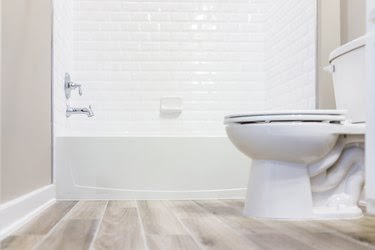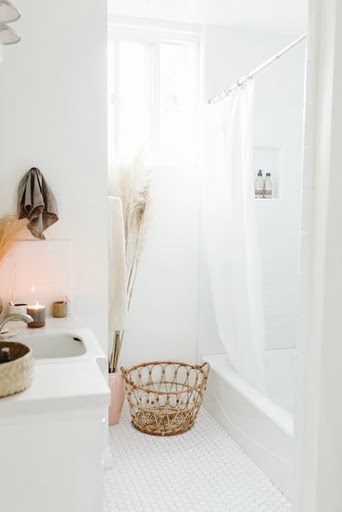Quck answer
To remove shower wall panels, follow these steps:
1. Turn off the water supply to the shower and remove any fixtures or accessories attached to the panels.
2. Use a utility knife to cut through the caulk or adhesive holding the panels to the wall. Start at the corners and work your way along the edges.
3. Carefully pry the panels away from the wall using a pry bar or putty knife. Be gentle to avoid damaging the panels or the wall.
4. Once the panels are removed, clean the wall surface and remove any remaining adhesive or caulk.
5. Inspect the wall for any damage or mold. Make necessary repairs before installing new shower wall panels.
Remember to take precautions and wear protective gear, such as gloves and safety glasses, when removing shower wall panels.
Acrylic and fiberglass shower wall panels are a popular choice for DIY home improvement projects due to their ease of installation. However, removing them can sometimes cause damage to the walls. When removing glue-up panels, the damage may be minimal, such as torn drywall paper. However, removing direct-to-stud panels requires removing part of the wall, which may include removing a row of tiles along the top and side edges of the surround.
Overview of the Removal Process
When removing multipiece shower wall panels, it is important to follow the order in which they were installed. This is because there may be overlap at the corners, with the first installed panel partially covered. The typical sequence for removal is to start with the corners (if applicable), then remove the side walls, and finish with the back wall. Some multipiece panel sets have interlocking joints at the corners, which need to be disconnected before the panels can be taken out.
Removing a single-piece shower surround presents a different challenge due to its size. Removing it in one piece may be impractical, so cutting it into smaller pieces is recommended. An angle grinder or oscillating tool can be used for this purpose. It is important to wear goggles and protective gloves during this process, as well as during any tile removal that may be required.
While it is not necessary to turn off the water to remove a shower surround, it is always a good precaution to do so. Additionally, the faucet trim, tub spout, showerhead, and shower arm should be removed. Most shower handles can be easily removed once the set screw is taken out. If the set screw is difficult to locate, it is likely hidden behind a cap that can be pried off.

Image Credit:
krblokhin/iStock/GettyImages
Items Needed for Removal
- Utility knife
- Tongue-and-groove pliers
- Rag
- Stiff putty knife
How to Remove Glue-Up Shower Wall Panels
Removing glue-up shower wall panels is a less complicated process compared to removing direct-to-stud panels. It requires fewer tools and less time. Heating the front of each panel with a hair dryer can make the removal process easier by softening the adhesive. However, this can also create a messy situation with the adhesive becoming gooey. It is recommended to try removing the panels without heat first and only use the hair dryer if necessary.
Step 1: Take off the Plumbing Trim
Unscrew and remove the handle, tub spout, showerhead, and optionally the shower arm. Use a utility knife to cut the caulk around the escutcheons for easier removal. If you need to use pliers to remove the spout, showerhead, or shower arm, protect the fixture with a rag to prevent damage to the finish.
Step 2: Cut the Sealant Around the Surround
Utilize a utility knife to cut through the caulk on all sides of the panels, including where they meet the rim of the tub or shower base. If there are multiple panels in the surround, there may also be a caulk seal where the corner panels overlap the side and back panels. Remember to cut that as well.
Step 3: Pry Off Any Molding
Insert a stiff putty knife behind any molding installed on the outer edge of the surround and pry it off with the putty knife.
Step 4: Remove the Corner Panels (if Applicable)
Starting from the top outside corner, tap the putty knife behind one of the corner panels and pry it out. Continue tapping the putty knife deeper until you can grip the edge of the panel with your fingers or pliers. Keep tapping and pulling until the panel comes off, then move on to the other corner panel.
Step 5: Remove the End Panels
Starting from the top outside corner, tap the putty knife under one of the end panels and pry it out enough to grip it. Tap and pull until the panel comes off. Remove the panel on the other end of the shower enclosure in the same manner.
Step 6: Remove the Back Panel
Use the pry-and-pull method to remove the back panel. Once it is off, you will need to repair the wall, mainly by cleaning up glue residue and fixing any torn paper in preparation for a new shower wall.

White bathroom with shower and wicker basket on floor
Image Credit:
Sanford Creative
Things You’ll Need
-
4-foot level
-
Pencil
-
Oscillating tool
-
Hammer
-
Flat bar
-
Mason chisel
-
Drill
-
Screw bit
-
Cat’s paw
-
Utility knife
How to Remove Direct-to-Stud Shower Wall Panels
After removing the shower faucet trim, the removal of direct-to-stud shower wall panels begins by uncovering the nailing flange around the panel’s perimeter to access the fasteners holding the panels to the studs. It is advisable to do this systematically to minimize the amount of repair work needed on the walls.
Step 1: Mark a Cut Line
Using a 4-foot level and a pencil, draw a level line on the drywall above the shower enclosure. It is best to make this line at least 6 inches away from the enclosure to allow space for work. If the walls extend more than 6 inches past the panels, also draw vertical lines along the side walls of the enclosure. Otherwise, it is easier to remove the entire wall covering along the vertical edges of the panels.
If the wall has tiles, take out a few rows of tiles around the edge of the panel set using a hammer and chisel. Start by chipping into the grout line above the row you want to remove, then angle the chisel into the tile and tap it to remove it. Once one tile is removed, the rest will be easier to take out.
Step 2: Cut along the marked line and expose the nailing flanges.
Use an oscillating tool to make a clean cut along the line, then chip out and remove the drywall between the line and the panels using a hammer and flat bar.
For tiled walls, cut through the cement board or other tile backer along the edge of the remaining tile, then pry out the cut pieces to expose the studs.
Step 3: Unfasten the panels from the studs.
The panels may be secured with screws or roofing nails. You can easily unscrew screws using a drill and screw bit. Use a cat’s paw pry bar to remove nails. Place the claws behind the head of a nail and then leverage the pry bar against the stud to pull out the head.
Step 4: Cut the sealant.
Use a utility knife to cut the caulking that seals the panels to the tub rim or shower pan. If you’re removing a multipanel set, also cut the caulk sealing the panels together.
Step 5: Remove the panels.
Remove the panels in the opposite order that they were installed. Start with the corners, then move on to the sides, and finish with the back panel. The corner and side panels may be connected by a latch system. To unlatch them, lift the panel you’re removing straight up until it comes free.


